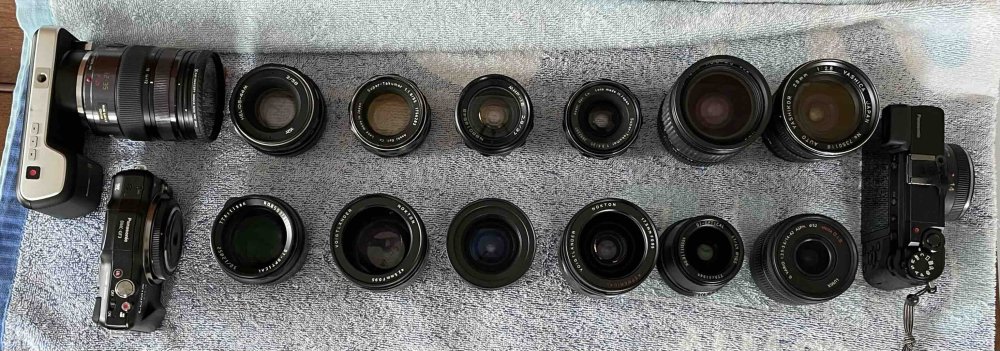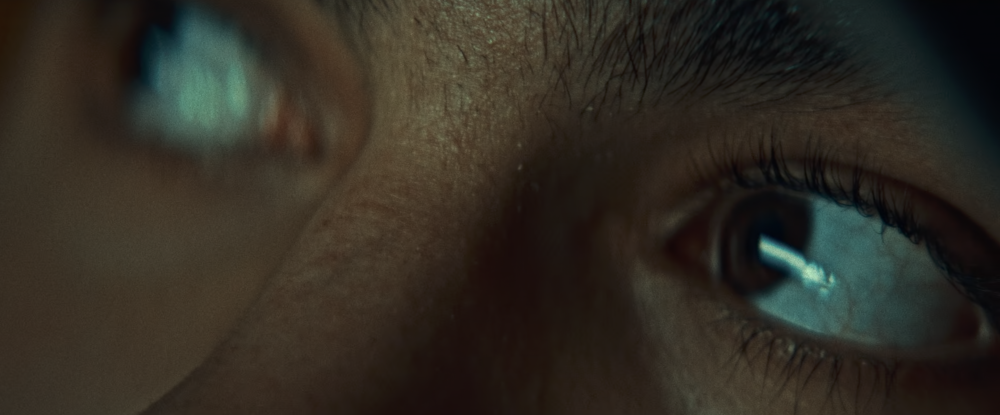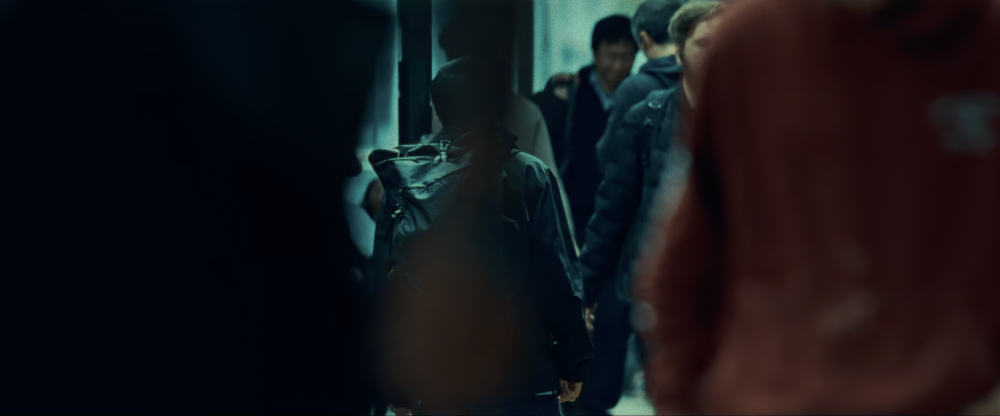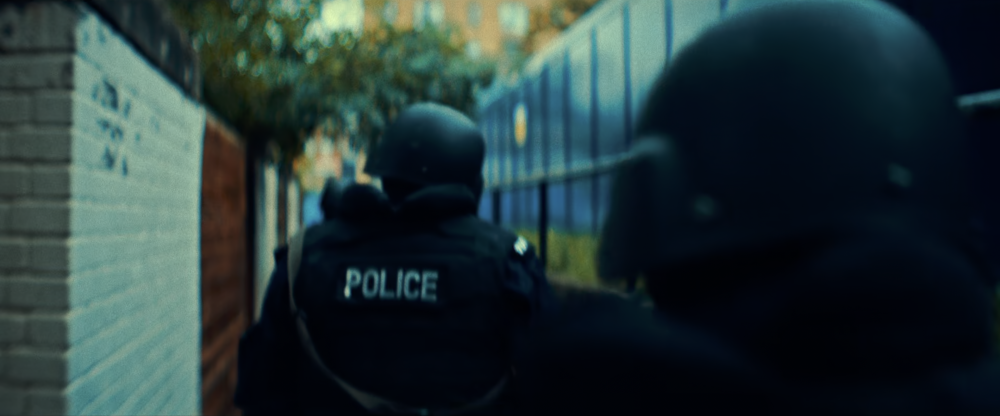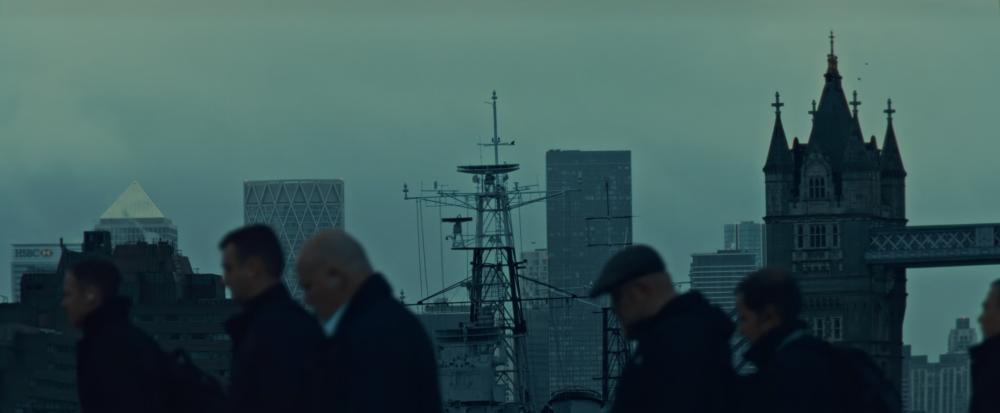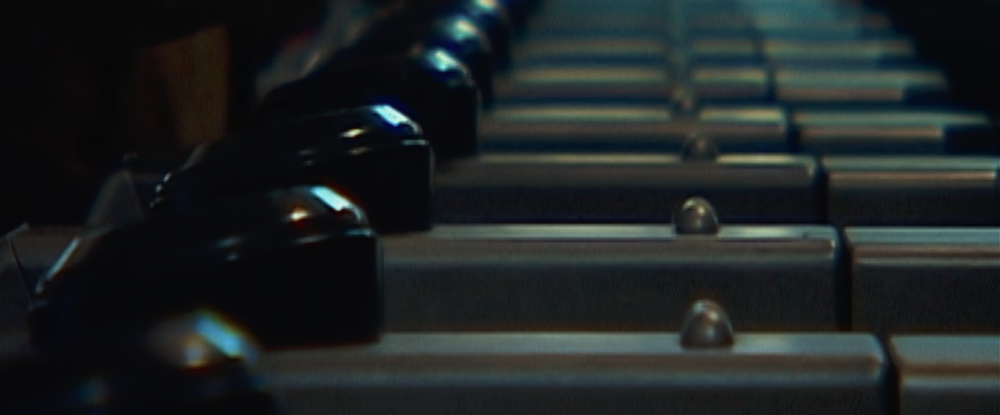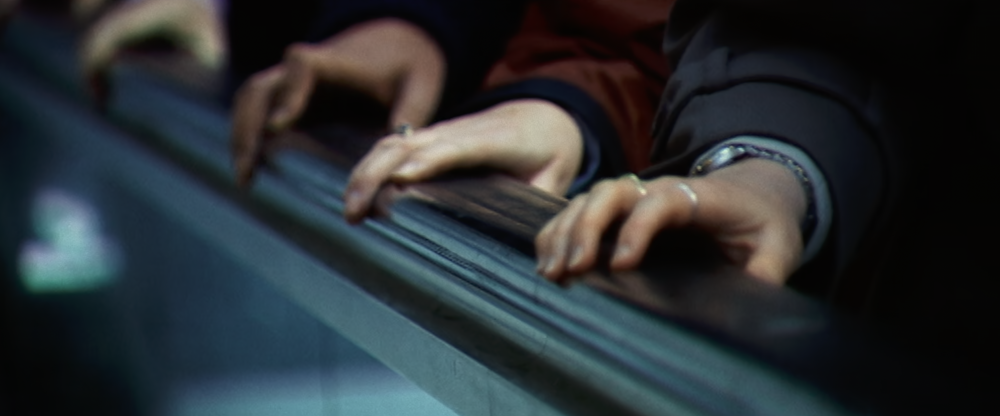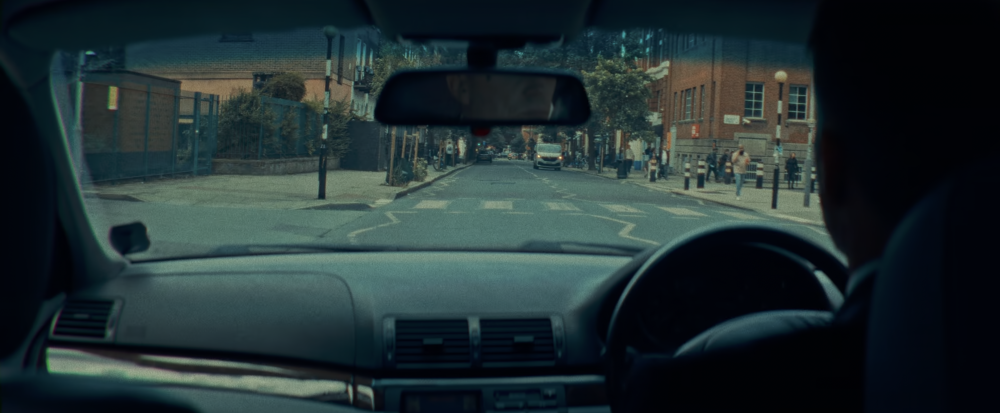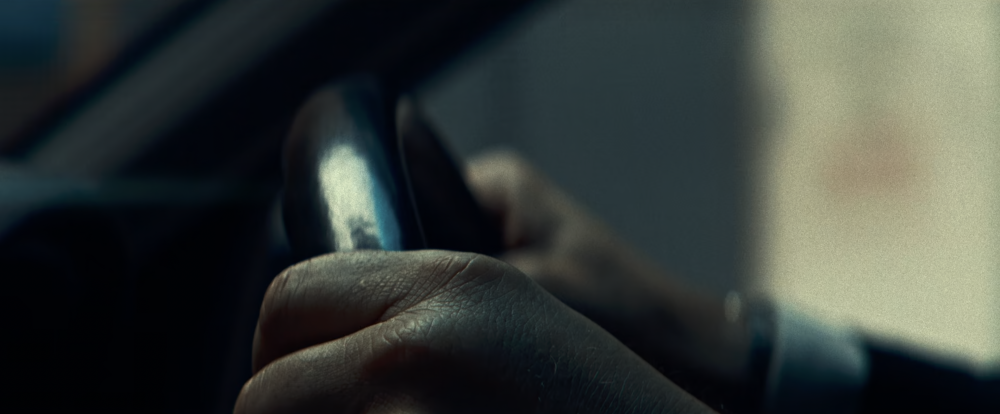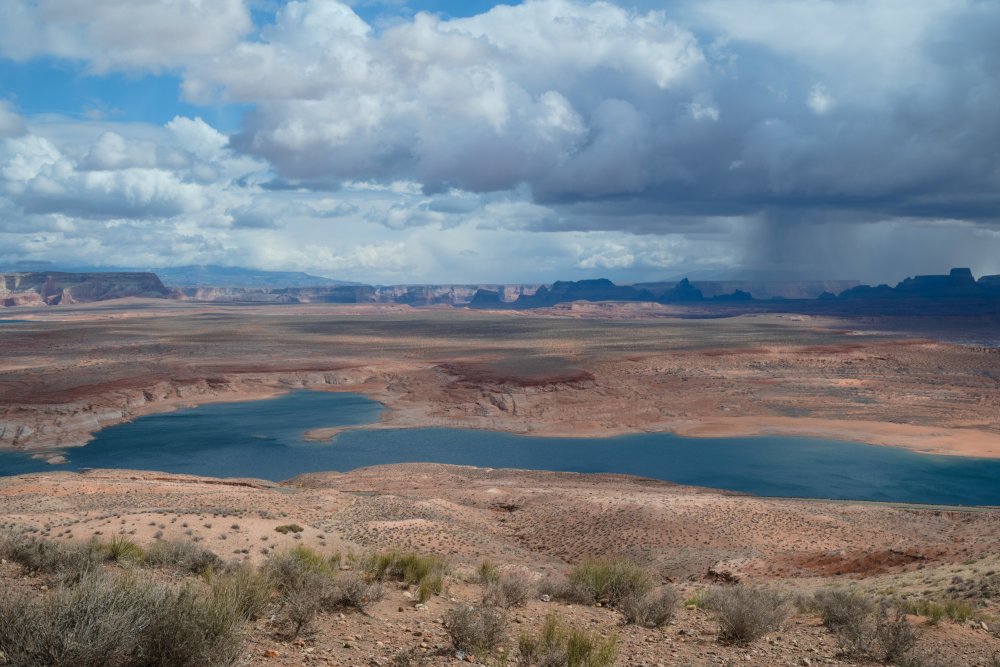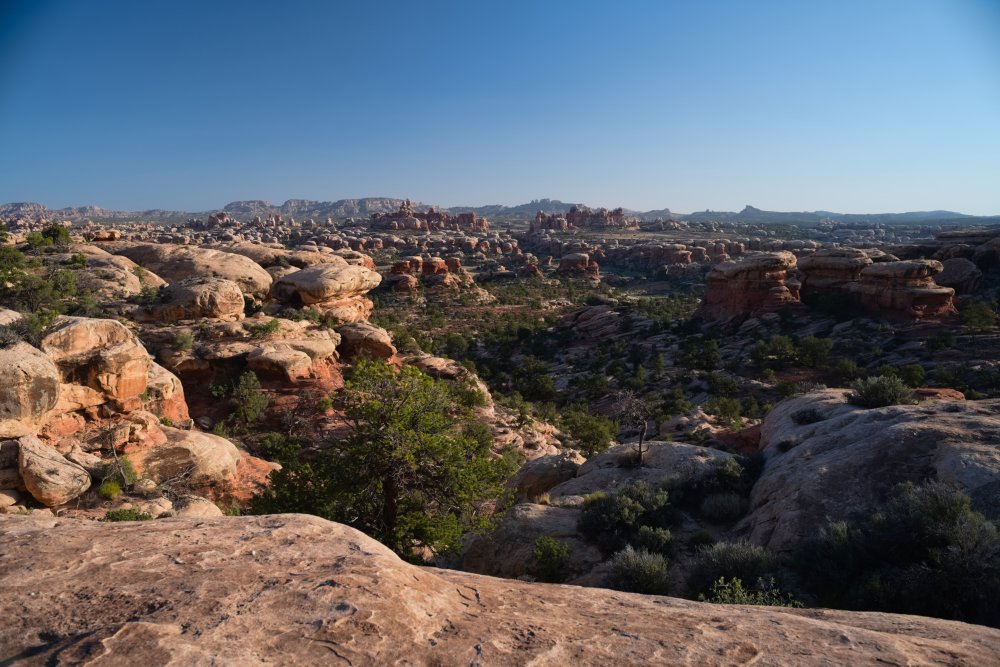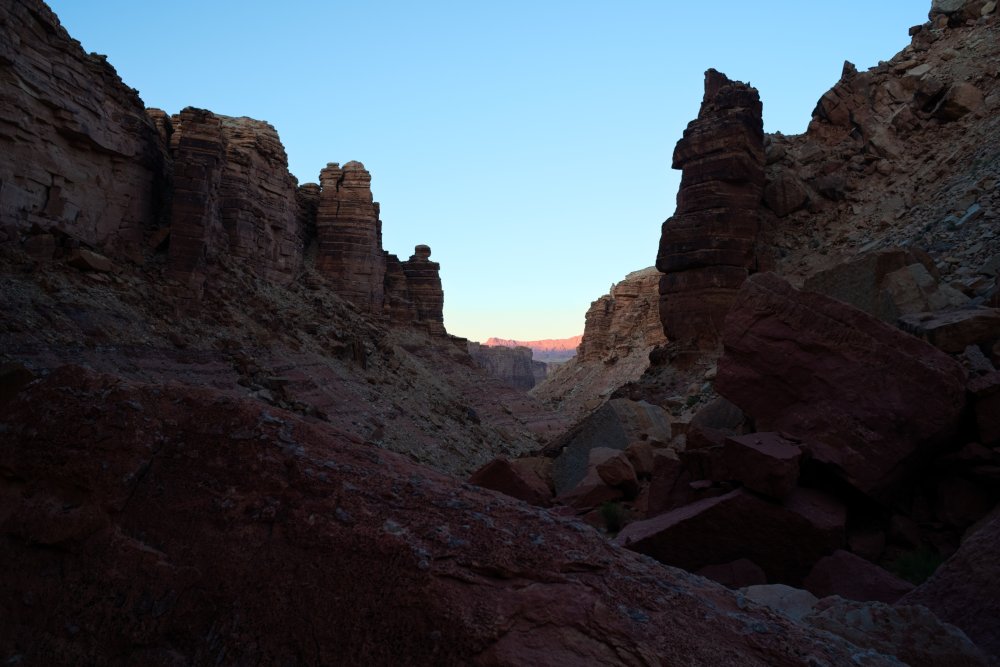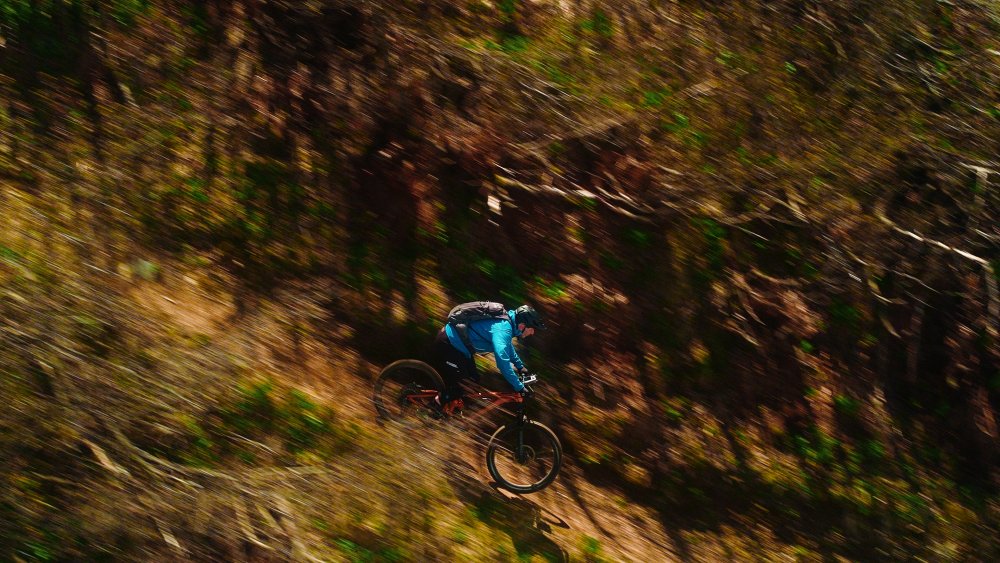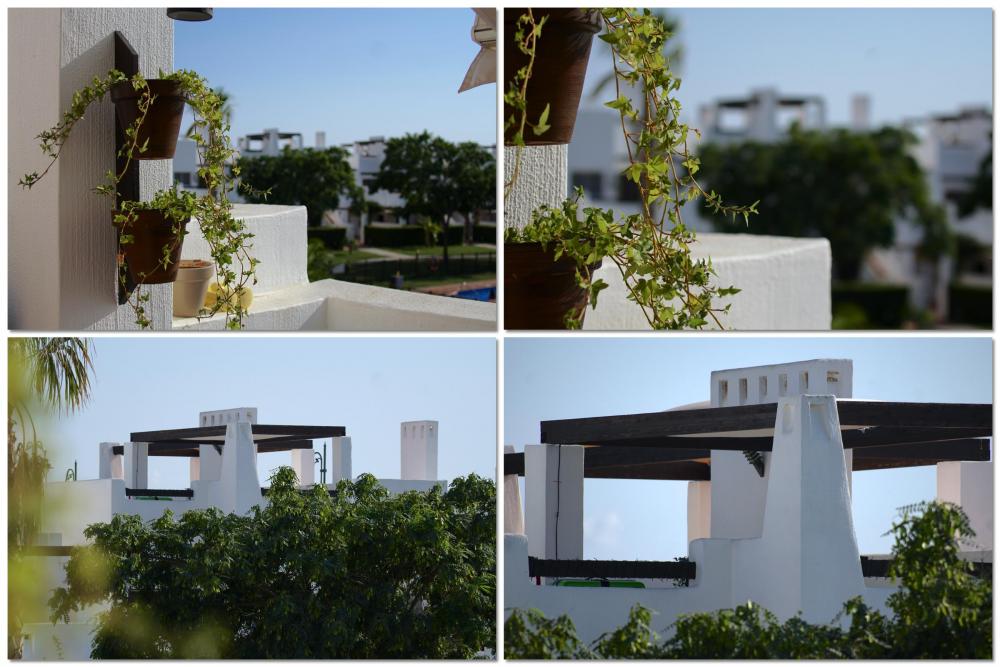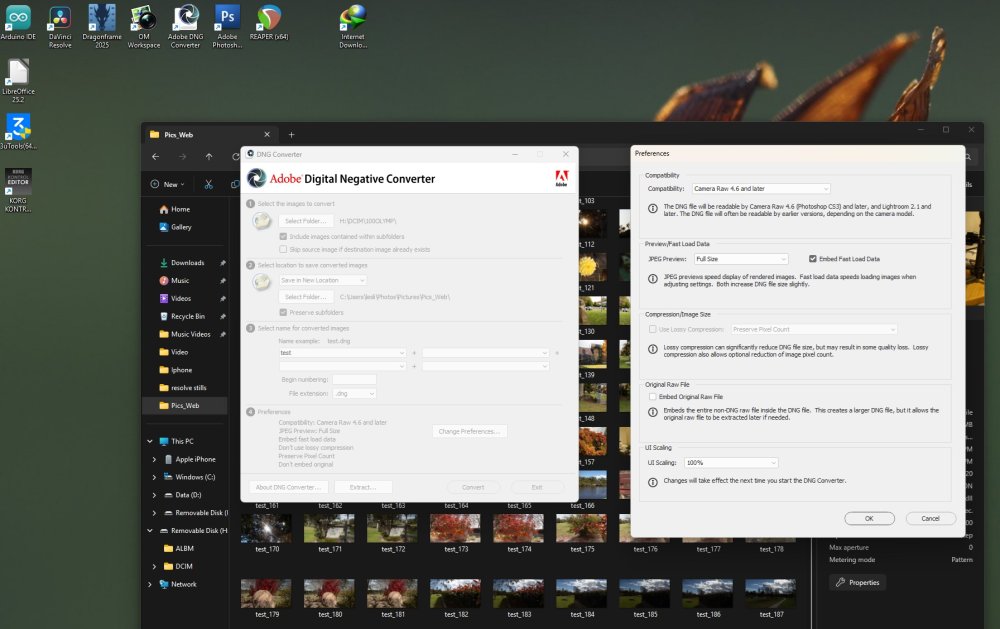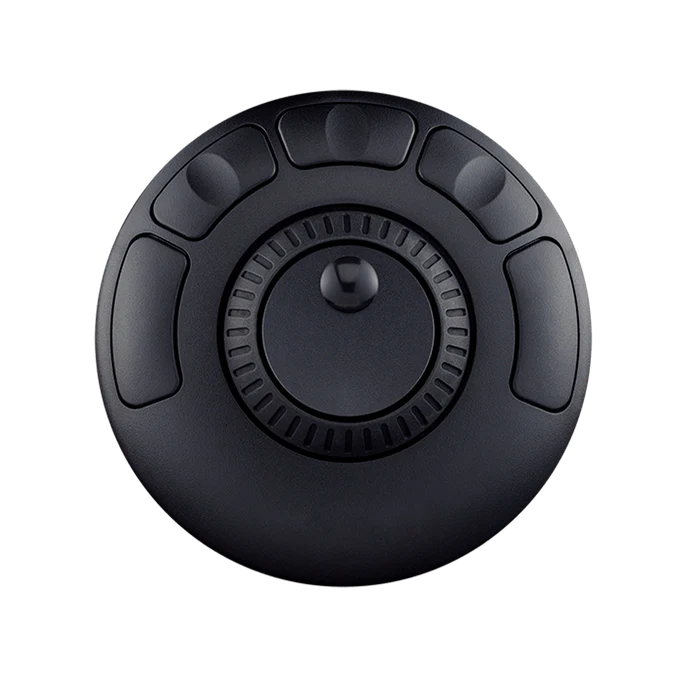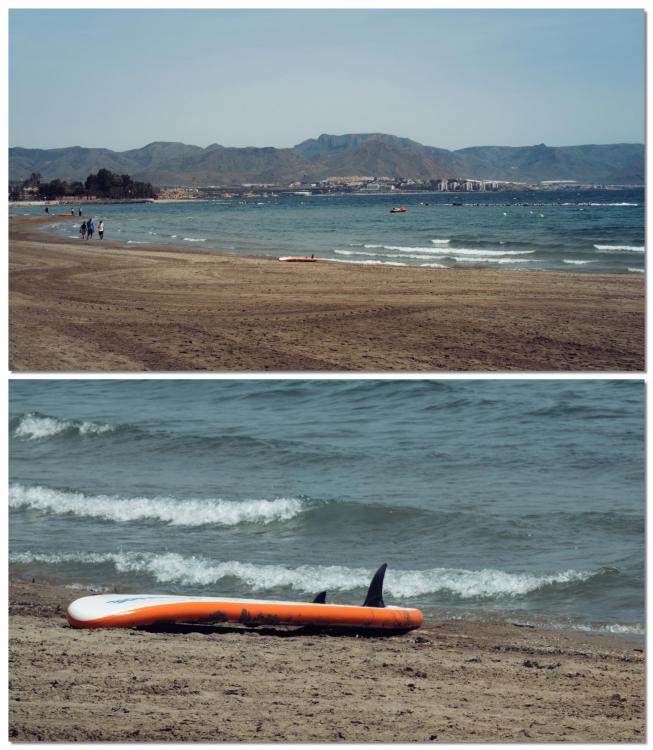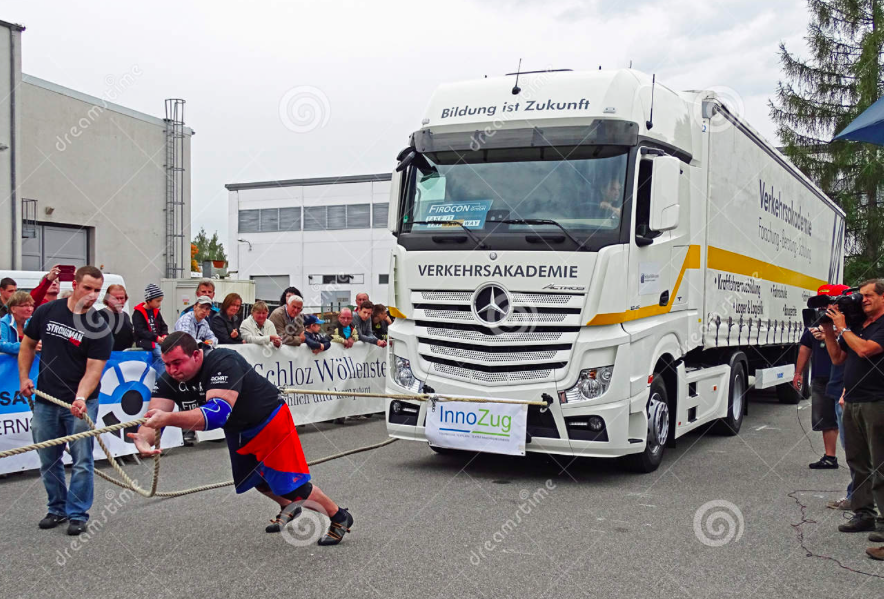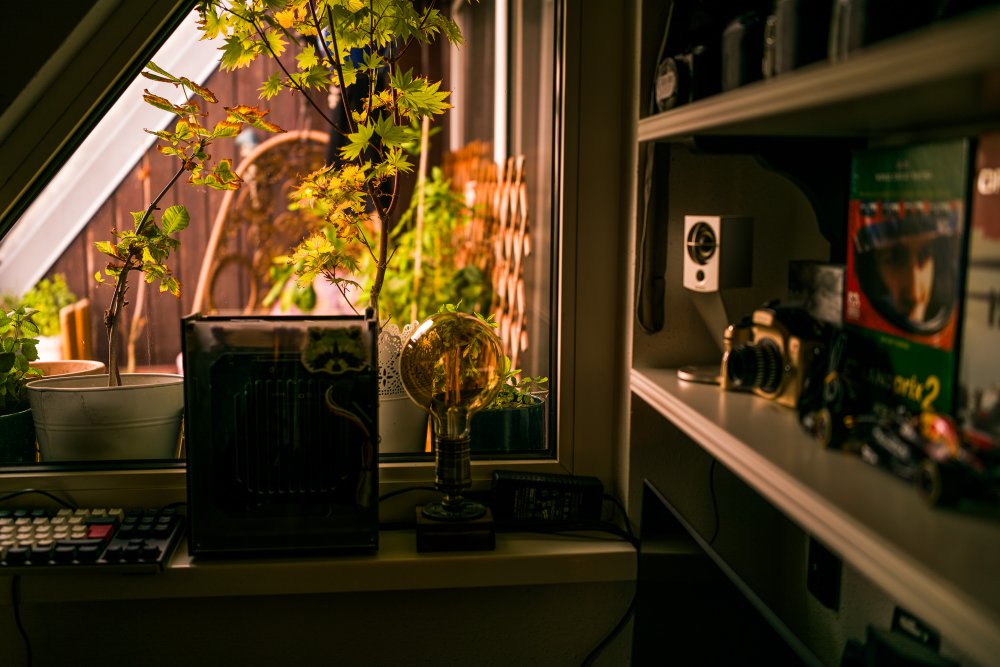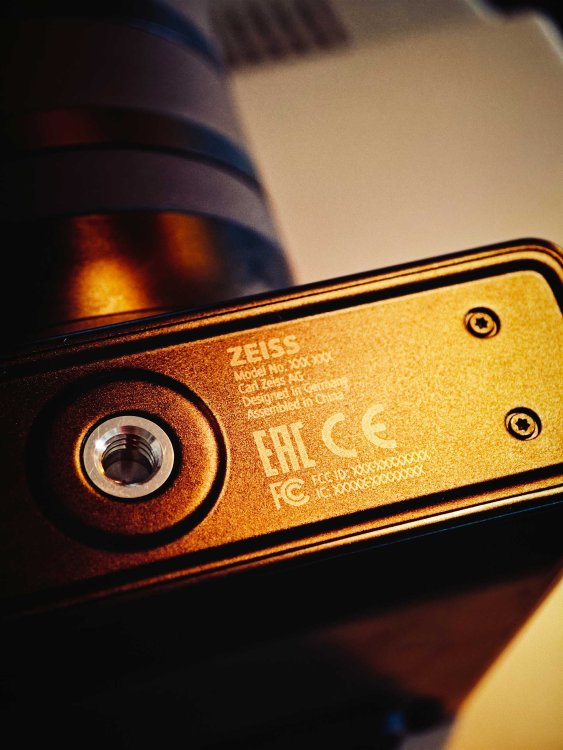Leaderboard
Popular Content
Showing content with the highest reputation since 07/05/2025 in Posts
-

The Aesthetic (part 2)
TrueIndigo and 2 others reacted to kye for a topic
There is a time for a clean aesthetic. There is a time for a more timeless more filmic aesthetic. There are times for a far grittier aesthetic too. Those who have been following my other thread will know I've mostly got my travel / walk-around AF setup nailed. (GH7 and GX85 bodies combined with the 14-140mm zoom, 12-35mm F2.8 zoom, 9mm F1.7, and 14mm F2.5 pancake lens) This setup will give a relatively clean starting point which can be graded to create a pretty wide range of looks. However, not everything can be achieved in post. I have also collected a bunch of modern MF lenses and vintage lenses over the years and these might be useful in creating other looks that I can't do in post with the above kit. So I'm trying to work out if I should just archive them or if they're still good for anything I want to do, and if so, what might that be? I've looked through my continually growing collection of lens comparisons, but found nothing conclusive. Thus begins a moderately sized lens / camera test... The setups included in the test are below. The details in brackets are the FF equivalents. OG BMPCC + 12-35mm F2.8 (35-100mm F8.0) This setup is included as I think it will be a reference for the rest of the setups (at worst) and might end up becoming part of my standard kit (at best). GF3 + 15mm F8 (30mm F16) This setup is included as it's essentially a modern Super-8mm camera, and considering it is absolutely tiny and takes the same batteries as the GX85 it's almost inconsequential to bring on a trip. GX85 with: Modern: Panasonic 12-35mm F2.8 (24-70mm F5.6) Modern: Panasonic 14mm F2.5 (28mm F5) Modern: Panasonic 14-42mm f3.5-5.6 (28-84mm F7.0-11.2) Modern MF: TTartisans 17mm F1.4 (34mm F2.8) Vintage: Cosmicar 12.5mm F1.9 SB (36mm F5.5) Modern MF: Voigtlander 17.5mm F0.95 (35mm F1.9) Vintage: SB + Yashica 28mm F2.8 (40mm F4.0) Vintage: SB + Tokina 28-70mm F3.5-4.5 (40-100mm F5.0-6.4) Vintage: SB + Takumar 35mm F3.5 (50mm F5) Vintage: SB + Mir-1B 37mm F2.8 (53mm F4) Vintage: SB + Takumar 55mm F1.8 (78mm F2.6) Vintage: SB + Helios 44M 58mm F2.0 (82mm F2.8) Modern MF: Voigtländer 42.5mm f0.95 (85mm F1.9) Modern MF: TTartisans 50mm f1.2 (100mm F2.4) I haven't included all my lenses, but the ones I have omitted have been included in other tests previously and are broadly similar to ones I have included, so if they become interesting as a result of this test I have some more reference materials. I watched a doco on Netflix the other day called Attack on London, and was really inspired by the look of the 'recreation' images they have obviously filmed for the doc, and seem to have used one of the filthiest anamorphic lenses around (and potentially added more dirt in post as well). Here are some screenshots.. These might not have been streamed at the highest bitrate available, but I don't care - they look great and have so much texture and feel. This isn't the exact aesthetic I'm going for, but it's one that I saw recently that has a lot of texture and FEEL. My hope is to work out what the ingredients are to getting this kind of feel and then work out when I would want it and then work backwards to what equipment and processes I'd use to get it. My initial impressions (guesses) are that the ingredients are: shallower DoF lower levels of sharpness decent amounts of grain film colours (especially having a tint and having subtractive sat) The above images have more elements to them than this, but I don't care much for things like CA etc, so I don't think they're part of the minimum required elements. I plan to shoot comparisons with the setups above in a range of different scenarios and then see what I can see, before moving onto the post workflows and what role those play.3 points -
I have the S1RII and the S1II. I also still have the old S1 and S5. The S1II is the same than the S5II about video details, even if some youtubers said the details rendering has improved, it's not true at all. Same bad rendering as the S5II. I understand some people are not bothered or can't see the difference and it's nothing wrong about that, but the difference is clear by example if you zoom inside your videos on people faces. Like the S5II, there is a sort of rough detail sharpening and in the same time a lack of very fine details. As always V-log looks better than the 709 profiles but it's still not great in my opinion. The S1RII also has the same detail rendering and I was very disappointed by the 6,4K Open Gate, it was not better than the 6K of the S5II, maybe even worse, like if this mode used a tiny bit of binning like the 5,9K 16:9. The new 7,2K is ok and looks better than the 6,4K. The 8,1K Open Gate is even better but limited to 24fps. Even if the video engine is the same between the S1II, S5II and S1RII, the later has much more resolution in 8K, hence the fine details looks finer even with the bad processing. it's only when the footage is a bit underexposed or overexposed that the S1 6K looks better. I read somewhere something interesting about Real Time Lut, using a burned in lut with a good amount of contrast helps to recover fine details. When recording V-log without Real Time Lut and grading in post, some fine details can't be recovered. I can confirm it's true. So using Real Time Lut V-log on the S1RII in 8,1K Open Gate is the best for details rendering. I'm glad Panasonic has fixed the colored pixels issue in Prores Raw on the S1RII and now the footage looks great, same details rendering than on the S1 or S5. But it's really crazy we must use Prores Raw to get the same good details rendering than on the S1 or S5 H264/265. And the crop is a shame, 1,45x ! When cameras like the Z8 or Z6III offer 6K or 8K 60fps raw video without crop ... About the S1II, Prores Raw only has a minimal crop (about 1,05/1,1x I think) and it was the main reason I bought this camera. Like on the S1RII, Prores Raw is excellent and like it has much less crop, fine details looks even sharper (in a good way). Finally we have a Panasonic camera with not only excellent IBIS but also excellent detail rendering and good AF without using external recorder (even if Prores raw is a pain for the workflow). The only issue I found is the 240fps 1080p mode, it is clearly not finalised because some horizontal lines appear randomly. I also found the photo raw files of the S1II and S1RII to be slightly less contrasty than the S5 and S1, they have less that punchy looks and I still prefer the rendering of the S5 and S1 with my best lenses like the 50mm S or 24-70mm Pro. it can be because of ACR but the JPEGs out of the cameras also looks slightly less contrasty than on the S5 and S1. Other than that, IBIS is stellar but sometimes more digital than on the G9II or GH7, color science is good but not as good as the GH6 to my eyes. The S1II also has better AF than the S1RII and I can feel the difference. Compared to Nikon, Lumix has several advantages like the IBIS and Open Gate. L-mount also has great "practical" lenses but I think they lack really great lenses with very nice rendering and more pancakes. After using most of the L-mount lenses, only a few looks really fantastic, like the 50mm S Pro (if it has not the coating issue), 24-70mm S Pro, 28-45mm Sigma and the APO Summicron SL. While absolutely great, the APO SL are really too much expensive for most people and it will be hard to attract a lot of people in the system, it is why Lumix try to attract people with smaller lenses and never released again new S Pro lenses since 2019/2020. Nikon has better AF most of the time but also more great lenses. The 50mm f1.8 is much better than the Lumix, the Nikon 35mm/50mm/85mm f1.2 and 135mm f1.8 are some of the best lenses you can buy. You can also adapt Sony FE lenses and there are more interesting "cheap" lenses available from third party manufacturers like Viltrox (mainly the 35mm f1.2 and 135mm f1.8).3 points
-
Share our work
maxJ4380 and one other reacted to KnightsFan for a topic
It's been a while since I've been able to work on any kind of movie, but here are some recent landscapes photos. I'm not doing anything artistic, just trying to capture some of my favorite places the way they felt at the time. The only edits are very slight changes to saturation and exposure. 90% of my photos are from 10+ mile hikes so I only bring my lightweight 28mm and a CPL, but in this group is a rare photo taken from the roadside using a 24-105.2 points -
Le Faux Bolex
andrgl and one other reacted to Clark Nikolai for a topic
I stumbled on this GitHub project. Not sure what to think about it (and suspect it might not be real). They're using the same sensor as the Digital Bolex and 3D printing a similar shaped body. No mention of an A to D board, just the chip going in to a Raspberry Pi. I remember the original Digital Bolex team took a few years to get the sensor's quadrants aligned and to get the colour science sorted out and these guys' sample images look great after only a short time. Maybe all this stuff is just faster to figure out nowadays. https://github.com/lafauxbolex What do others think? If real this would be great! They're changing some things from the original: A M4/3 mount, a big monitor and compressed DNG files.2 points -
I don't recall if it was added in Resolve 18 or 19 but with the new feature you don't need to grab the still. It works in edit and color page, File -> Export -> Export Current Frame as Still (I have mapped to F4). What is great it keeps the folder selection and the file format but you can change it at anytime, the file name will use timeline name + a time code as default. So what I do is spacebar for play/pause, left or right arrow to select the best frame, hit F4 and Enter to save. Much faster that the old Still Grab process.2 points
-
It is since many years that I take stills out of the video instead of taking pictures, this is why I’m shooting mostly in 8k RAW. I use Resolve, remapped the F4 key to export still, I first grade for the video, copy the timeline so I can do some tweaking to the grade still by still, if I like the result, I hit F4 and export the jpg, if I want to do a complete different edit I export as a tiff and edit in camera RAW. I normally do a quick pass in camera RAW to do the cropping as in Resolve is a pita as you would need to change the timeline resolution. It would be cool to have an AI tool that finds the good ones especially when I use the 180 rules that finds the one with the no motion blur on the face. Right now, is a bit of a tedious move forward/backward.2 points
-

Arri is the new Adobe
Davide DB and one other reacted to Andrew Reid for a topic
Surely the main point is that if you can afford to shoot ARRI Alexa 35 you are not quibbling over software licensing fees over the week(s) long duration of a shoot. Whereas with Adobe they scavenge £ from grandmothers and students for years and years.2 points -
Arri is the new Adobe
alsoandrew and one other reacted to Ilkka Nissila for a topic
In Arri's case they offer (1) Alexa 35 with all features included in the purchase price, (2) Alexa 35 base model with the most commonly used features enabled, and (2a) subscription to optional features that you may need for a specific project, (2b) permanent licensing of those features that you want to keep, so the subscription is just one option and permanent licenses to those features are available if you want them. I don't understand what the issue is. Having more options in how the payment is made is good and means more people/companies will be able to afford the stuff. No one is complaining that leasing or renting cars (or getting a taxi ride) are available in addition to the option of purchasing and owning a car. Public transport tickets are available on a single trip, load value, or pay for use for a period of time basis. Again no one is complaining about the existence of these options. Why then is subscription software or firmware as an option a problem? I think people are complaing about these things because they don't understand that software development costs money and if you want to continue developing a particular piece software in the future you probably need to keep those same people who developed it continuously employed so that you can do it efficiently in the future. If you have to let the people who developed something go, to add features, the cost is multiplied because no one new initially understands the existing code. The subscription model works best for software because it enables continued employment so the knowledge of how the software works internally is not lost. Today since operating systems are continuously changed, the applications software also needs frequent maintenance. So for Adobe the subscription model works best. They are able to maintain broad hardware support and have a huge library of cameras and lenses that are supported in terms of raw processing and lens corrections. The subscription cost is really low for the (still) photography software kit (LR + PS) and while the other stuff is kind of expensive, it was always expensive even in the then-thought-permanent license era. And as there are free or inexpensive options available for the tasks which Adobe prices expensively (Davinci Resolve instead of Premiere Pro), there is something for everyone available in the market. What would be much worse is that people rely on a particular product and have a lot of material made with it and suddenly those files could not be opened or edited as a result of the company making the software ending their operations or support of the product.2 points -
Arri is the new Adobe
alsoandrew and one other reacted to eatstoomuchjam for a topic
I only made it about 5 minutes through the video before I got bored with it so maybe he addresses some of this after that. But I'm not sure why it's news that Arri give people an option to buy the full camera or a base model that disables some features until they're enabled. That's been a thing for a long time. When one buys the base model, there are options to pay to enable those features on a temporary or permanent basis. It's one of the reasons that when you see used Arris for sale, they'll frequently say things like "includes high-speed license" or "includes raw license." Speaking for myself, I kind of hate subscriptions in general for this kind of thing, but that is very much mitigated by having the option for a permanent license. I still don't like it a lot since (in most cases), it's not really reducing the camera price. In the case of things like the GH4/5, it's not like Panasonic would have needed to charge more for the camera if they just threw in vlog-l. In Arri's case, I suspect that the decision was pushed by big rental houses - if I'm a rental house, a reduced cost base model lets me buy more cameras. Add a license to enable certain features and I can just tack that onto the price of the rental. Renting for a week? X dollars. You want raw on that rental? Add Y dollars. Camera reaches end of service life, the buyer can turn on any feature they want on a permanent basis. I don't love it, but it's not terrible.2 points -

Share our work
kye and one other reacted to fuzzynormal for a topic
Over the past decade I've been a part of thirteen independent micro or no-budget budget films. Five of which I'd actually feel comfortable enough to show to strangers and say, "I've done this." It's weird because I've never been too precious about IQ. My personal-tech-craft-sloppiness-indifference does show in the final product, but only if you're looking real hard (at least I think so). I kind of want to be better, but I also don't really feel a strong pull to eek out that extra little juice, you know? I'm more interested in trying to shape a story by putting a bunch of note cards on the wall in the writer's room. Anyway, I've held tight to my LUMIX cams since the 20-teens. Also have an Oly cam. Haven't bothered to upgrade much. I know I'm missing out on the latest and greatest, but when I look at stuff a decade old vs. the film I just finished, and I think they both look a-okay, I guess I'm just not the type of filmmaker that's eager to change gear. Anyway, if anyone wants to see those five films I mentioned, let me know. I've posted them here before, but can share anew.2 points -

Panasonic GH7
Davide DB and one other reacted to John Matthews for a topic
EH FILMS gave an interesting take on the GH7:2 points -

Panasonic Lumix S1R Mark II coming soon
eatstoomuchjam and one other reacted to MrSMW for a topic
Not especially no, but then maybe that’s because I am a hybrid wedding shooter and not a serious filmmaker? I mean it is/was on the list, but in no way would I switch to a camera purely just because it has marginally better highlight roll off when it isn’t so great in other areas, or completely misses the mark. My criteria as I stated was I am replacing both a 61mp and a 24mp cameras for a 44mp one. For stills which are 50% of my work, absolutely no way would I be considering a 12mp camera as a viable alternative. Does the A7Siii meet my requirements for ‘all in one system’? Sure as does the A7iv, the A7RV and well…any/all A7 and FX bodies, but do any of them meet my requirement to shoot 6k open gate video? Nope, not a single one. As I outlined in my reasoning, I have a minimum set of requirements in order to make any change and one of those was not better highlight roll off. I don’t think you are necessarily being ‘that guy’, but you completely ignored my requirements and instead posed a question based on what I guess would be your main priority. And that’s cool. But regarding highlight roll off specifically, have I considered it? No, not really. I’ve used full-frame Lumix now for 4.5 years and at no time have I considered it an issue and looking at the footage from the S1Rii that I have seen, haven’t noticed anything untoward. I haven’t looked at or even aware of any comparisons in this specific area either. So back to my best Scooby Doo voice, “Idunnoknow” 🤷♂️2 points -
Decision made, I am sticking with LUMIX regardless of what Nikon or Sony do next. S1Rii inbound... Here's my reasoning and intentions for those that are interested in such things! Currently I am using: S9 + 2x S5ii for my video work, plus a Sony A7RV and a Nikon Zf for stills. That's 5 camera bodies plus 9 lenses spread over 3 systems with 3 different menus, batteries, handling/haptics etc. In summary, it works, but not without issues. I am switching to 4 camera bodies plus 7 lenses over 1 system. I have 3 principal aims: A: Reduce the amount of kit I have to work with and B: Have it all within one single cross-compatible system. C. Ability to pull 6k stills from video footage on a consistent basis. Nikon is or was an option with Z8 + 2x Z6iii + Zf and all my Tamron e:Mount lenses would work just fine, but the negatives for me are mainly; no write to second card back up, Vlog is easier/better to grade and looks better to my eye (marginal but looks that way to me) and costs a few thousand more than an all LUMIX line up. Sony has the best lens lineup options for me and I prefer the FX style bodies by a large margin, but no 6k camera (at least for now) kills it for me. Nikon may come out with this rumoured ZR for 2026 and it may answer some of my current Nikon criticisms...but it may not and if it does, c'est la vie, 'sideways' rather than anything I actually need. Ditto Sony. It's the lens lineup mainly that is the draw and if there was a 6k camera available now, I would probably have gone in that direction and in FX style bodies, it would have sealed the deal, but again, even if that comes into being by the end of this year, too late for me and I'm not a brand hopper for the sake of the latest new thing just because it's the latest new thing, ie, this current crop of ex-Sony Shillsters to now LUMIX Shillsters are all going to be hopping back in the direction of Sony within the next 6 months for sure. Nope, I can't and won't do that. If I have a Porsche, I might look at Ferrari or Aston and think, "yep, they're nice, but I already have a Porsche and it's fantastic". (I don't, - I have a used 150,000 miler Skoda Octavia Scout 😜 ) I'm 2 weddings in to a 17 wedding season and the new boy won't arrive in time for the next 2 which I leave for on Monday, but at least the 13 jobs after that will all be with the new system which will now comprise the following: S1Rii with Sigma 28-70mm f2.8 until I have sold all the stuff I need to sell and then will be picking up the Sigma 28-45mm f1.8 for indoor use and use my existing LUMIX 70-200mm f4 for outdoor use. I hate lenses that extend with zooming and neither of these do! Hybrid use, - mainly stills but I will also shoot video with this. S9 with 18/50/85mm f1.8 on freestanding monopod which is my current and going forward will now share duties with the S1Rii as my 'run & gun' units. Pair of S5ii's remain as my 2x statics with any 2 of the above 6 lenses that are not in use on the S1Rii or S9 at any given time, but at some point, I am going to add the Sigma 28-105mm f2.8 into the mix, ie, still 1 less body and 2 less lenses than I have currently been using this year and last, but the 28-105 will give me a bit more flexibility that my current L Mount lens lineup lacks. The only thing that put me off doing this sooner really was the body design... It's not that exciting and I was hoping for something more S1H or even Sony FX style but upon reflection, it's a better body than the S5ii being slightly chunkier, a MUCH better rear LCD and a few knobs and whistles that improve the overall use. Dream camera? Probably not, but a very very solid move (for me) I think. The bottom line is once you have pushed that button, how do you feel about it and will I miss the A7RV and Zf? I feel good about it actually because the positives outweigh any negatives and the Sony + Nikon pairing has been stellar, but there is simply a better (for me) option now. 7.2k 30p Open Gate Vlog here we come...2 points
-
Lenses
kye and one other reacted to eatstoomuchjam for a topic
Speaking of IS, the entire thing culminated in me buying a 24-70 f/4L IS from somebody on ebay - since an irrelevant search result when looking for info on the 28-300 reminded me that it existed - and it's smaller and lighter than the 24-70/2.8L II and has IS. And being an f/4 lens, it's not popular and cost me less than $400 used. If I decide to bring the R5 as a second camera, I'll just put that on it and call it good. The entire combo will be smaller than some of the Fujinon lenses for GF. 😅2 points -
I have this lens and this is a simple range example from one spot that I did with it for someone on here many moons ago. It is actually more like a 70-200 f2.8 size wise for carrying but that is down to it being a push pull design which isn’t exactly great for smooth continuous zoom shots. But is ideal for practising the trombone.2 points
-

Return of the Crop King, but only for RF? (Sigma 17-40 f1.8)
Emanuel reacted to Marcio Kabke Pinheiro for a topic
Liked the lens, probably will get that in the future. Probably the casualties on my side will be the two Nocticrons, the 35mm and 50mm. Lovely and cute little lenses, but I almost do not use them - this year I probably only used the 18-50mm f/2.8 zoom and the Viltrox 75mm 1.2.1 point -
It depends if you are doing a lot of run and gun, can't live without Open Gate (because I think this feature is not just usefull but also give a real full frame look to the image) and appreciate some tricks like DR BOOST (at the cost of high rolling shutter). If yes, the S1II and even the S1RII are really a good choice, even if you like photography and if you can afford the Leica APO Summicron SL and the 24-70mm/50mm S Pro. If you don't have the need for the best IBIS or don't need to record while walking, Nikon is maybe a better alternative. AF is generally better even if the S1II is really not bad and more accurate than the S5II and S1RII. If you shoot wildlife, Nikon is also a much better choice, especially with the Z8, because Nikon has more tele lenses , better RS, unlimited burst and no blackout. The S1 and S1RII, while they have very fast burst (70fps for the S1II), you can only shoot for about 2 seconds, which is ridiculous. The Nikon S f1.2 lenses are excellent, they are more affordable, faster and have deeper bokeh than the APO SL. However they are heavier, bigger, and maybe less suited for video. If you are on Windows and use Resolve, Nikon with N-raw is much easier to edit than Prores Raw, both the S1II and S1RII only have Prores Raw. N-Raw is supported by Resolve and you have the lenses corrections backed in the files, you can even choose to record N-Raw directly in 709. Prores Raw is supported by Premiere Pro but there is no WB/ISO option. You also have the option to record 6K60fps (Z6III) or 8K60fps (Z8), on the S1II you only have a slightly cropped 6k30fps, it's worse on the S1RII because of the big crop. Outisde of Raw I think I also prefer the output of the H265 codecs compared to Lumix, Nikon is sharper but retains more fine details. So to resume : -IBIS is much better on Lumix. -DR is slightly better on Lumix (with DR BOOST or DRE ON). -Lumix has more nice features than Nikon (Open Gate, Real Time Lut etc). -Color is subjective but I really like the output of the S1RII. -AF is slighter better with Nikon even if the S1II is now closer than ever. -Video quality (fine details) is slightly better on Nikon (in RAW they are the same but N-Raw allows 60fps raw no crop). -For wildlife, Nikon is better, but keep in mind the Z8 is heavier than both the S1II and S1RII. -Nikon has more great lenses, Leica ones are as good but much more expensive. For me, as I like to do a lot of run and gun, Lumix is still the better choice for video but I need more editing time to get what I want because of Prores Raw. For stills, I don't shoot a lot of wildlife but I really like the Nikon S 1.2 lenses rendering. Leica lenses are also stellar, but you trade fast aperture and bokeh for more POP and significantly less weight. I think the S1RII is maybe the better choice if you don't need to shot fast scenes because the 8K H265 quality is pretty good, the IBIS is excellent, the AF is enough for most things and you can record Open Gate. The S1II can be the best choice if you need low rolling shutter and want the best detail rendering (Prores Raw) IBIS and DR. Like the S1RII you have Open Gate, but the big issue for me is the detail rendering with non raw video. The Open Gate 7,2K and especially 8K just looks much better on the S1RII. The Z8 is probably the best choice for stills in most cases, especially for wildlife. The video is outstanding too. But the camera is not lightweight, the IBIS is also much worse. The Z6III is a very good compromise, not as big as the Z8, 6K60fps is more than enough because the detail rendering is great. Maybe there is some bad shadows noise at some ISO but I think the issue is overrated since the last firmware update, like the DR slightly worse below ISO 800 compared to the Z8, it's really hard to notice a difference. But it's maybe because I don't shoot at very high ISO. For now, I decided to keep only the S1RII,S1II and Z6III. I will wait only a few months, if the next Nikon Z (with RED) has better IBIS, the choice will be obvious for me. But if Panasonic releases some new S Pro lenses very soon, it will be much harder to choose which system to keep.1 point
-
Arri is the new Adobe
eatstoomuchjam reacted to maxJ4380 for a topic
i think i'm on version 17.2.00 of dng converter, their all backwards compatible. I convert to camera raw 4.6 as its the last version listed for cs3. it pretty simple to use, select your directory and hit convert, er.. pick a directory to save your files otherwise you'll waste 10 minutes wondering where they went... Its a 1.6 gig dl which makes it a fair size. Its free as well. its a handy program, once you have a dng, the worlds your oyster. either photo or video editing, you can do image sequences as well, which avoids the banding you get with jpg's, if your into timelapse or hyperlapses or some form of animation. Camera Raw 2.4 and later: The DNG file will be readable by Camera Raw 2.4 (Photoshop CS) and later, and Lightroom 1.0 and later Camera Raw 4.1 and later: The DNG file will be readable by Camera Raw 4.1 (Photoshop CS3) and later, and Lightroom 1.1 and later. The DNG file will often be readable by earlier versions, depending on the camera model. Camera Raw 4.6 and later: The DNG file will be readable by Camera Raw 4.6 (Photoshop CS3) and later, and Lightroom 2.1 and later. The DNG file will often be readable by earlier versions, depending on the camera model. Camera Raw 5.4 and later: The DNG file will be readable by Camera Raw 5.4 (Photoshop CS4) and later, and Lightroom 2.4 and later. The DNG file will often be readable by earlier versions, depending on the camera model. Camera Raw 6.6 and later: The DNG file will be readable by Camera Raw 6.6 (Photoshop CS5) and later, and Lightroom 3.6 and later. The DNG file will often be readable by earlier versions, depending on the camera model. Camera Raw 7.1 and later: The DNG file will be readable by Camera Raw 7.1 (Photoshop CS6) and later, and Lightroom 4.1 and later. The DNG file will often be readable by earlier versions, depending on the camera model. Camera Raw 11.2 and later: The DNG file will be readable by Camera Raw 11.2(Photoshop 20) and later, and Lightroom 8.2 and later. The DNG file will often be readable by earlier versions, depending on the camera model. Camera Raw 12.4 and later: The DNG file will be readable by Camera Raw 12.4 (Photoshop 21) and later, and Lightroom 9.4 and later. The DNG file will often be readable by earlier versions, depending on the camera model. Camera Raw 13.2 and later: The DNG file will be readable by Camera Raw 13.2 (Photoshop 22) and later, and Lightroom 10.2 and later. The DNG file will often be readable by earlier versions, depending on the camera model. Custom: Backward Version: DNG 1.1, DNG 1.3, DNG 1.4, or DNG 1.6 (default 1.6)1 point -
This is extremely helpful, and also a bit disappointing. Thank you so much for your detailed response. It seems like there is ample reason to hold out for the S1HII, still.1 point
-
The 7.2 will be my new go to over my current slightly less than 6k from the S5ii. At least I think it is… 5.9 or something? Anyway… The 8.1 limited to 24p is a bit of a bummer but hey ho. I have not done any ‘scientific’ testing, but switched to that approach 1.5 years ago for other reasons, but I felt my work looked better immediately. Also using a 1/8th mist VND I am sure is responsible for zero moire. Ever. Plus ability to bake in the LUT plus twin card recording caused 4 winning points over Nikon, but Nikon does counter with superior lens options, especially with adapter E Mount as part of the equation. Super-tight call for me but the 4 winning points narrowly beat out the glass for me. They have 2 holes in the lineup for me: An equivalent of the Tamron 70-180mm f2.8 which is MUCH smaller and lighter than the Lumix or Sigma 70-200’s and there is NOTHING in L Mount even close. An equivalent to Sony’s 50-150mm f2. Grail lens right there for me. I now do not care about the weight because is just the PERFECT lens for me but in order to have it, I’d need to build a Nikon or Sony based system around it and Sony doesn’t even have 6k (yet, but less than great 8k in the A7RV and then you have to go AII or whatever it’s called) and with Nikon, a ton of stuff I’d need to give up. For pure stills, Nikon. For pure video, Lumix. For hybrid, I could make a case either way and have done based on capabilities for my specific needs sacrificing my perfect lens to do it with Lumix.1 point
-
Thank you for your thoughts, Wondering Hypothetically if you were to start from scratch right now, would you still go Lumix or Nikon?1 point
-
Arri is the new Adobe
Davide DB reacted to eatstoomuchjam for a topic
I hadn't thought about that, but if that's an option, I guess I could have done it. Though at this point, I doubt I have an installer around for the old version. Yes, for someone who needs multiple or many Adobe products, the current pricing is somewhat advantageous vs the old pricing. A lot of people, me included, are not that person and use Lightroom almost exclusively. The only time I use Photoshop is when I need to run SRDx. The current cost for the entire suite is $70/month - over 3 years, that's $2,520. So... wow. That's an additional $20 in cost over $2,500. So it doesn't seem "much cheaper" to me. It seems to be "the same cost." This is the pitch that is made for subscription software. It's not applicable to most people. I use Lightroom often enough that it doesn't make sense to turn on and off my subscription all the time. There's no need to guess. They went with it because it radically increased their profits and gave them a steady predictable monthly revenue instead of an unpredictable spiky revenue that got reduced if people didn't like the new version. Now it doesn't matter if you don't like the new version. F U consumer, you are paying for it anyway. Here are some charts that show the true reason that Adobe went to a subscription model - prior to it, they had a pretty consistent/flat 4-5 billion dollars per year in revenue. This is plenty of money to develop their software. It has been on an upward ramp since then and now they are making 20 billion dollars per year. If it flattens again, expect them to increase subscription pricing to further enrich their shareholders. This is why subscription models exist - to enrich shareholders, not to make your life better. I used to work for a major e-commerce company - discussions of subscription billing, etc, were very rarely phrased in terms of the benefit to end users. https://www.macrotrends.net/stocks/charts/ADBE/adobe/revenue The free version is intended to stay. Petty said in their NAB livestream that he expects that, at some point, people will be asked to pay for upgrades to the Studio License to fund continuing development of Resolve. This is, for me, fully acceptable. My existing version of Resolve Studio will keep working as long as it needs to work and if I find the features in a new version to be compelling, I will pay them for it. This is a healthy business relationship.1 point -
Arri is the new Adobe
eatstoomuchjam reacted to maxJ4380 for a topic
Pardon my ignorance, cant you use adobes dng converter to change raw file to dng's ? you can then do anything you want. Well thats how i get my raw files into photoshop cs3 and that has to be older than 2017 lol. I guess there's probably some sort of image loss going on in any conversion however my 58 year old eyes don't notice it.1 point -
Arri is the new Adobe
Andrew Reid reacted to eatstoomuchjam for a topic
Is the last sentence intended a a joke? Lightroom-only subscriptions are $12/month. That's $144/year. In 2017, Lightroom cost $150 and you could use that copy of Lightroom for as long as you wanted. If Adobe released a new version with features that you didn't want or need, you didn't need to buy it. And this might blow your mind, but... about 95% of the "features" that Adobe have added since going to the subscription model are things I don't need, want or use. https://fstoppers.com/apps/creative-cloud-it-time-ditch-adobe-200441 Unfortunately, the version from 2017 has no chance of opening any files that I take with my modern cameras. Previously, I would have probably bought a new version of Lightroom every 2-3 years, as needed, to support my new camera. Now I have to spend 3 times as much to continue using my photo editing software. And again, many of the features that Adobe add are completely disjointed from what I would want. Making me pay 3x as much to keep using the software to support the development of features that I don't want is not a consumer-friendly practice. I'm not sure what malfunction you're having that makes you think that Adobe wouldn't have developed things like better denoising and debayering algorithms if they released new versions of the software that people had to pay for. In fact, they might have spent more time on those things. And if they released a new version that didn't improve that and only added, for example, AI object insertion, I could punish them by not buying it and continuing to use the software I already had. Now, punishing them is also punishing myself because I have to learn to use entirely new software, transfer 20+ years of images in a catalog, and find new plugins (which sometimes don't even exist, such as SRDx which I use to clean up dust from film scans and only works with Photoshop). Do you work for Adobe? You seem really motivated to say how paying more for their software so that they can develop features that many users don't want is somehow good for the users.1 point -

Panasonic Lumix S1R Mark II coming soon
eatstoomuchjam reacted to MrSMW for a topic
Bingo. If you are a paid up member of the L Mount Alliance, then you use an S5ii for this specific task. Otherwise the rest of this overheating hype is just that, over-excited hype. OK I get the expectation that just because the S5ii or the FX3 can do X then the new Lumix cameras should, but actually maybe not and the S1Rii especially is a photo-centric hybrid that can do excellent video and even the S1ii is not really a ‘cinema’ camera but a hybrid. Just use the right tool for the job!1 point -
Arri is the new Adobe
Davide DB reacted to KnightsFan for a topic
As much as subscription models suck for us individuals, they are often preferable for businesses, even regarding software like Adobe. Obviously Arri's target market is rental houses, and the comment earlier about a rental house passing those temporary upgrades to customers is quite likely the intent. It's worth spelling out the difference between subscription editing software and camera upgrades, though. With Adobe's product, if you stop paying, you can't open your old projects. In Arri's model, if you stop paying, you can presumably still open files shot with those upgrades. Losing access to the creative work that you've already done is a big difference.1 point -
Arri is the new Adobe
Davide DB reacted to eatstoomuchjam for a topic
I thought/assumed that the choice of cameras for f1 were similar to the reason that studios have been using Ronin 4D for a bunch of stuff - and why the last couple of Mission Impossible films used Z Cams for the stunts - because there's no Arri that could possibly fit in the places where they put the custom Sony cameras (just as there's no Arri that can be usable on a gimbal as quickly as the R4D can be ready and because there's no Arri that can fit in a lot of the places that the Z Cam does). It's not to say that the Venice line isn't really good, it certainly seems to be, but on a movie with a budget of $100,000,000, the difference in price between shooting on Alexa and shooting on Venice is basically a rounding error.1 point -
Panasonic Lumix S1R Mark II coming soon
mtol reacted to Framed_By_Dan for a topic
I'd like to know too, especially about the S1II and using the Rec709 profiles (Natural specifically). Everyone who's reviewed the S1II has done so using V-Log or Raw. I've read that it's not quite as aggressively digitally sharp as the S5ii/S5iiX but still showing some heavy NR and smoothing of fine details. I might have to get a loan of one for myself to see whats what.1 point -
Arri is the new Adobe
Davide DB reacted to eatstoomuchjam for a topic
I was with you on "it's OK to have a license as long as there's an option for perpetual," but this is the part where you're losing me. Subscriptions, as currently implemented by companies like Adobe, are actually extremely consumer-hostile. You're right that it's good to have an ongoing source of revenue, but you're completely ignoring that they now have no impetus whatsoever to build features that people actually want. If I have Lightroom 5 and Adobe release Lightroom 6, I can look at the features that were added. If none of them are something I want, I keep using Lightroom 5. If Adobe completely misses the mark with customers, few or no people buy version 6 and they are forced to course correct or go out of business. If they go out of business, the copy of Lightroom 5 that I have keeps working forever. Maybe eventually it won't run on a new computer, but I have virtual machines or my old computer as options still. In a subscription world, I pay Adobe every month to keep using the software that I already have. They can waste as much time and money as they want on shitty new features that I don't want or care about. I still have to pay for them. They want to spend 1000 hours developing an integration between Lightroom and a stock photo site so they can pull extra revenue through a deal with the stock photo company? I don't care and I'll never use it. But I'm still paying for it. The company spends a bunch of time integrating their own cloud service which would charge me even more money to store my files? Don't want it, probably will never use it, still funding the development. If a competitor has different features that I want, I can certainly move to their software, but unless the interface is identical to what I'm used to, now I lose time and effort re-training on how to use the other software. They know that a lot of people aren't going to take that time and effort so the money keeps flowing in. Plus maybe I've spent hundreds of hours in something like the Lightroom catalog rating and tagging things or doing some other activity that isn't necessarily stored in the XMP sidecar (not sure if ratings and tags are) and moving that to another software package would eat a ton of my life. Stop using the software for a while? Sometimes subscriptions are easy to pause or stop, but a lot of times, they are a pain in the ass to stop. Once again, extra money keeps flowing in because people forget the subscription or give up on cancellation because they'll probably need it again sometime in the future. You are arguing against yourself here. If I own the software and it doesn't have to check a central license server every time it starts up, I can open my files in perpetuity. Virtual machines are a thing and allow running older software basically forever. On the other hand, if I had a file created in some version of Adobe's software in a format that isn't supported elsewhere (not sure if this exists) and I don't pay a ransom to Adobe, those files are now dead to me. Also, if Adobe decides to stop supporting that software because not enough people are paying the subscription, those files can never be opened again. Go offline for a month because you're traveling in the middle of nowhere and/or don't want to pay for a local sim? Sucks to be you, you won't be editing anything after a few days because the software can't phone home. This is increasingly a concern in the gaming industry as well - there's even a petition and a movement within Europe about it at https://www.stopkillinggames.com/ Companies intentionally build their games to require an online connection and if it's gone, the game stops working. Meanwhile, eventually most people stop playing and it costs money to run/patch/maintain the servers so the company turns them off. Wanna play that game that you loved a few years ago? Too bad. Even if you have it still installed on your computer, it now serves no purpose other than to waste disk space. Anyway, Adobe announce record profits all the time. I'm still using Lightroom about like I was 10 years ago. I should probably try Capture One again. I have kind of hated it every time I installed it, but at least their model is less offensive - option for a perpetual license or subscription, and if converting from subscription to perpetual, some of the subscription costs are prorated toward the purchase.1 point -
If I understand correctly what you mean, I think so... I have used stills previously, but not 'matching' stills. What I am proposing going forward is ensuring my video and stills match perfectly in the grade and if frame grabs intended to be used as stills, identical to that exact frame in the video. The primary intention and purpose is to cut back drastically on stills photo capture in the first place and therefore also editing time and move towards a more cohesive and less time intensive approach. So currently I'll do a full capture, cull and edit etc on both photo and video. Going forward, I'd like to capture even more video and reduce the stills capture back to just certain elements, mainly details and family groups. Pics will be captured in raw + Jpeg 3:2 ratio with my LUT baked into the Jpegs (which is the same LUT I bake into my video footage in camera). I normally bin the Jpegs and use the raws, but I am proposing using the Jpegs and simply keeping the raws as backup just in case. Edit the video timeline to the point where it's still in 3:2 open gate format and then pull the frame grabs for use specifically as stills, rather than to insert back into the video. I can then go back into the timeline and put my more 'cinematic' 17:9, or 2:1 or whatever crop on it, and add all the twiddly bits that are video specific such as any text, transitions etc. Et voila, a finished wedding film plus a set of stills that look like frames from a movie. As intended, ie, when someone says, "your photos look like frames from a movie", it will be because most of them are. Anyway, I am going to give it a go as all last year, this year so far and the next 2 jobs, I've been shooting stills on the A7RV and Nikon Zf with 90% of the footage for my wedding films coming from the S9. After these next 2 jobs are in the bag, the A7RV and Zf get replaced with a single S1Rii shooting 7.2k 30p clips and the S9 which was shooting video exclusively at 6k 30p, will be shooting a mix of some stills and some secondary video. Pretty sure it will be a good set up based on the kit I have and some of the trials I have attempted, but as with all these things, it's only when you climb out of the trench and charge the enemy, with bullets flying, you truly know. Or you step on a landmine and it all goes tits up.1 point
-
Not AI but this will significantly speed up the manual process and is a good all round productivity booster in general. For this task (and you can have multiple presets for other tasks) I’d have the left and right inner buttons assigned to the Première Pro keyboard shortcuts for previous and next clip respectively, the centre button to play/pause, one of the outer ones for the export shortcut and the jog shuttle for the jog shuttle. Workflow would be hit the button to move to next clip, play/pause button and jog/shuttle to locate and then export key to capture. Rinse and repeat moving to the head of the next clip each time. Nothing you couldn’t do with mangling your fingers to do the shortcuts but far, far more ergonomic for such a repetitive task. As I say, they are just generally useful devices for everything editing related. And not a bank balance drainer at £65 either. Also, as it’s based on driving keyboard shortcuts it can move with you to different applications. https://contour-design.co.uk/products/multimedia-controller-xpress1 point
-
I just start a new timeline with the finished production as a single entity. Or rather that is what I have been doing to date with the few attempts I have made. I think what I will do now, for the rest of this year at least, is introduce a new chapter as it were in my process which is after culling, importing, colour grading, while the clips are all still 6k 30p on a 6k 30p timeline, but prior to any speed changes, transitions, graphics, text etc, is export a 3:2 6k copy and then pull the stills from that. These will then match my same baked in LUT stills also in 3:2. I can then import the results from both into Lightroom as a single set for any final grading and reexport as JPEGs. The only thing I hoped to do other than this was have AI find, select and export 350-500 frames from clips for me…amd maybe that software exists and if it doesn’t it should as that will be one of those things worthy of the title ‘game changer’. Kills or at least severely limits the photographer in me, but hey, choices…1 point
-
I last did some screen grabs in resolve 18, when i bothered to dl 20, i think they changed how you grab frames as nothing i did seemed to grab a frame. 20 was new at the time and there were no tutorials that i could find More by good luck than good management i figured it out. I do think its easier / faster in to do in 20. Just letting you know so you avoid some hiccups.1 point
-
The C100 would suffer from the same problem that all workhorse cameras suffer from - the best images from them are made by people who are so good at making images they don't post to social media and/or don't list their equipment if they do post. I wonder how many big budget productions have C100 shots mixed in with the C200/C300 main stuff but used the C100 as a higher-risk or mounted cam due to its size and relatively low cost if something happened to it. I've got the occasional beautiful image from my XC10 when the stars aligned and the location and lighting and composition were all working together, and that had a tiny sensor and 10x variable aperture zoom lens. The C100 almost matched it in pixel-peeing terms despite being 1080p and In similar situations the much larger sensor and ability to have nice lenses would be game over.1 point
-
Lenses
kye reacted to eatstoomuchjam for a topic
It has been on my "someday maybe I'll buy that lens" list for about 20 years now. Every year, the price comes down a bit more. Prices in the US are now about $500-600 and ebay prices from Japan are about $450. What's the inflection point where it goes from "maybe someday" to "buy?" Only time will tell. It was also superseded by a 28-300/3.5-5.6L which is a more useful range. Still a push-pull zoom along with the rude comments from friends that comes with that when using it. Used prices in the US are still high - $800+. Although... there is one on ebay for $400 which intermittently throws a communication error connected to the camera. Kind of tempted to take a flyer on that one and do the rubber eraser trick on the contacts - and if that doesn't work, disassemble the rear of the lens to see if it's a solvable problem... Exactly. It's important, when traveling, not to be too focused on a single specific outcome. In the end, it's about the adventure and the time spent together (the woman I'm dating lives in Brasil so we need to treasure our shared time, at least I can spend a few months there yearly because my job tolerates me working from there for a while). Renting a truck with a camper on it, there's always a danger that it breaks down and we miss some stuff due to lost time waiting for repair/replacement. By going with a vague itinerary, it's easier to focus on what we're actually doing vs fretting about things that will be missed (and if they are missed, just about all of them are guaranteed to be there if I ever choose to go back again). It's a strange world. 😅 Both of our countries feature landscapes from harsh desert to tropical jungle. Yours has a lot more aggressively dangerous flora/fauna, though. In mine, the danger is mostly from the residents of rural areas. In both places, there are spots to stand, breathe, and feel in awe of the amazing landscape sprawled out before you. (Even here in Minnesota, we have some places like that despite that it's objectively one of the most boring/flat states in the country)1 point -

Zeiss ZX1 full frame Android prototype, let's repair
Juank reacted to Andrew Reid for a topic
According to a book, Dutch company ASML got into a big fight with Nikon a few years back. They both make lithography tools for semiconductors industry. ASML's optics supplier is Zeiss. To pressure Nikon into a settlement, they had to take the patent fight to them in cameras. So ASML got Zeiss to make them a camera. It also doubled as a marketing adventure, shown off in stores but rarely really ever in stock. Until one day this popped up on my radar, with the serial number XXX XXX. The AF wasn't working, or the manual focus (fly by wire), lens stuck at macro 30cm. So I cracked it open, mopping sweat off forehead. Inside is 256GB SSD, final release model was bumped to 512GB. Android 6, with Zeiss test suite of apps onboard including FCC certification test suite 🙂 A music player. A Dutch full frame 36 megapixel sensor with some analogue colour. A Zeiss 35mm F2 lens (but different optics to the Sony RX1), 4K video (Super 35mm crop) and an EVF. And some weird prototype issues. I'll make a YouTube video on it. Sample shot And I still have no idea how I fixed the AF. Just wiggled the lens and sensor ribbon cables a bit and it started working properly, but there was no sign of either cable being loose in the first place! It is quite a fun tool, and a bit different. Android is decently snappy on it, the camera app is well designed, the physical dials are lovely but it doesn't have a joystick or command dials... So a lot is on the touch screen, but it's well done. Shall I root it? Update to 3.0 production firmware? (Risks bricking it). Given the rarity factor... I probably won't!!1 point -
Some anamorphic goodness. Splendid shortfilm with jojo players performing and offscreen statements about their art and what it means to them in living their lifes. I found the bts on youtube which linked to the actual video. Filmed in HD 240fps with a 20mm Laowa Nanomorph, in Arri C.1 point
-
Except for the price... ; ) AF @ 100/120fps and... I don't agree at all when reviewer hints MFT is more flexible as far as glass options when you can put them directly to FX30 via MFT -> E-mount adapter but not the opposite. How many cool manual lenses you can have at your disposal? Unique control along with PZ lenses for tracking shots from several speeds, only to mention a single advantage. Clear Image Zoom another one. When people like this scriba here are used to buy the most spread lens mount option to fit the more number of different cameras as much as possible, this is also something to have in mind such as the Megadap ETZ21 adapter to couple E-mount lenses to diversify the setup towards those new Nikon camera releases without losing AF capability. Other than that, better IBIS, higher resolution 5.7K @50fps and open gate recording are neat GH7 advantages. That said, first contact with this guy. Loved the way he gradually answered my questions at same time I was following his clean input as every reviewer should try the best for. In my bookmarks from now on. - EAG1 point
-
And so one feels like searching for the Naiads, beautiful and immortal freshwater nymphs that disturb the spirit of those who catch a glimpse of them emerging from the waters. Beliefs that embody the ambiguous feeling of fear and attraction to the waters. So far no Naiads and Nereids but only many sticklebacks! GH5MII and GH5S, various lens, natural light Sound ON1 point


